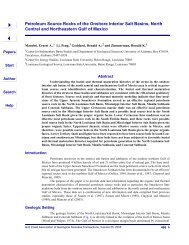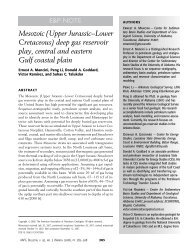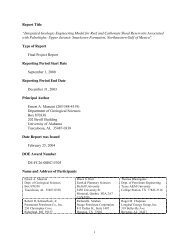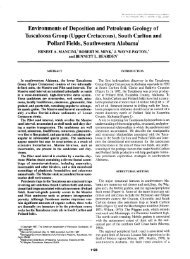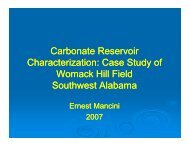Part 4 - Berg - Hughes Center
Part 4 - Berg - Hughes Center
Part 4 - Berg - Hughes Center
Create successful ePaper yourself
Turn your PDF publications into a flip-book with our unique Google optimized e-Paper software.
Caddo, Bossier, Webster, Claiborne, Lincoln,<br />
Union, Ouachita, De Soto, Bienville, Winn,<br />
Natchitoches, Jackson, Morehouse<br />
The Cotton Valley Group in southern Arkansas and northern Louisiana has been<br />
extensively studied (Crider, 1938; Imlay, 1943; Swain, 1944; Forgotson, 1954; Sloane,<br />
1958; Mann and Thomas, 1964; Thomas and Mann, 1966; Collins, 1980; Coleman and<br />
Coleman, 1981; Eversull, 1985; Zimmerman, 2000). The Cotton Valley consists of the<br />
Schuler and Bossier formations and lies unconformably on the Louark Group. The<br />
uppermost Schuler Formation, predominantly composed of sandstone and siltstone, is<br />
unconformable to and oversteps the Bossier Formation (mainly shale) near the basin<br />
margins. Continuous deposition occurred in the deeper parts of the basin. The basal<br />
Cretaceous Coahuilan Series rests unconformably on the Schuler Formation of the Upper<br />
Jurassic Cotton Valley Group. Swain and Anderson (1993), in ascending order, divided<br />
the Cotton Valley Group into the Millerton, Shongaloo, and Dorcheat formations. They<br />
defined the Millerton as dominantly a siliciclastic shelf unit that was deposited over the<br />
Haynesville Formation and used it in place of the Bossier Shale. These authors described<br />
the Shongaloo Formation as typical foreshelf and shelf edge silty shales and sandstones,<br />
in part, calcareous. They assigned the name Dorcheat Formation to the uppermost unit<br />
below the Hosston Formation and used it in reference to the Schuler.<br />
Kornfeld (1985) described the sandstones of the upper Cotton Valley Group of<br />
Mississippi, northern Louisiana, and eastern Texas as being deposited on a stable but<br />
subsiding shelf. The quartz-rich regressive sandstones are described as being deposited in<br />
a complex of deltaic and marine systems. The sediments of the Cotton Valley fluvial-<br />
deltaic systems were derived from Paleozoic and younger highlands to the north and<br />
356




